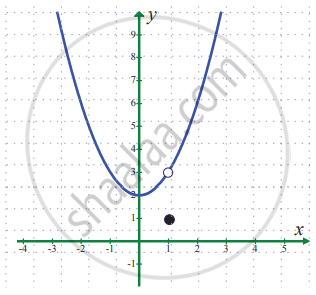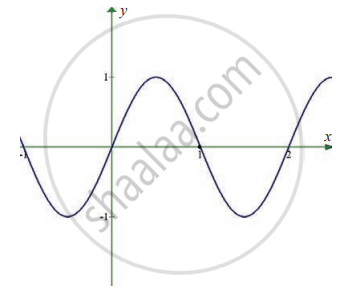Advertisements
Advertisements
प्रश्न
Evaluate the following limits:
`lim_(x -> 0) (sqrt(x^2 + "a"^2) - "a")/(sqrt(x^2 + "b"^2) - "b")`
उत्तर
We know `lim_(x -> "a") (x^"n" - "a"^"a")/(x -"a") = "na"^("n" - 1)`
`lim_(x -> 0)((sqrt((x^2 + "a"^2)) - "a")/(sqrt((x^2 + "b"^2)) - "b")) = lim_(x -> 0)(((x^2 + "a"^2)^(1/2) - ("a"^2)^(1/2))/((x^2 + "b"^2)^(1/2) - ("b"^2)^(1/2)))`
= `lim_(x -> 0) ((x^2 + "a"^2)^(1/2) - ("a"^2)^(1/2))/x^2 xx x^2/((x^2 + "b"^2)^(1/2) - ("b"^2)^(1/2))`
= `lim_(x -> 0) ((x^2 + "a"^2)^(1/2) - ("a"^2)^(1/2))/((x^2 + "a"^2) - "a"^2) xx ((x^2 + "b"^2) - "b"^2)/((x^2 + "b"^2)^(1/2) - ("b"^2)^(1/2))`
= `lim_(x -> 0) ((x^2 + "a"^2)^(1/2) - ("a"^2)^(1/2))/((x^2 + "a"^2) - "a"^2) xx lim_(x -> 0) 1/(((x^2 + "b"^2)^(1/2) - ("b"^2)^(1/2))/((x^2 + "b"^2) - "b"^2)`
Put x2 + a2 = y
Put x2 + b2 = z
When x = 0
⇒ y = a2
When x = 0
⇒ z = b2
= `lim_(y -> "a"^2)((y^(1/2) - ("a"^2)^(1/))/(y - "a"^2)) xx 1/(lim_(x -> "b"^2)(("z"^(1/2) - ("b"^2)^(1/2))/("z" - "b"^2))`
= `1/2 ("a"^2)^(1/2 - 1) xx 1/(1/2 ("b"^2)^(1/2 - 1))`
= `(("a"^2)^(- 1/2))/(("b"^2)^(- 1/2))`
= `("a"^(- 1))/("b"^(- 1))`
= `"b"/"a"`
`lim_(x -> 0)((sqrt((x^2 + "a"^2)) - "a")/(sqrt((x^2 + "b"^2)) - "b")) = "b"/"a"`
APPEARS IN
संबंधित प्रश्न
Evaluate the following limit:
If `lim_(x -> 1)[(x^4 - 1)/(x - 1)]` = `lim_(x -> "a")[(x^3 - "a"^3)/(x - "a")]`, find all possible values of a
Evaluate the following limit :
`lim_(x -> 1)[(x + x^2 + x^3 + ......... + x^"n" - "n")/(x - 1)]`
Evaluate the following limit :
If `lim_(x -> 5) [(x^"k" - 5^"k")/(x - 5)]` = 500, find all possible values of k.
Evaluate the following limit :
`lim_(x -> 0)[((1 - x)^8 - 1)/((1 - x)^2 - 1)]`
Evaluate the following :
Find the limit of the function, if it exists, at x = 1
f(x) = `{(7 - 4x, "for", x < 1),(x^2 + 2, "for", x ≥ 1):}`
Evaluate the following :
`lim_(x -> 0) {1/x^12 [1 - cos(x^2/2) - cos(x^4/4) + cos(x^2/2) cos(x^4/4)]}`
In exercise problems 7 – 15, use the graph to find the limits (if it exists). If the limit does not exist, explain why?
`lim_(x -> 1) f(x)` where `f(x) = {{:(x^2 + 2",", x ≠ 1),(1",", x = 1):}`
In exercise problems 7 – 15, use the graph to find the limits (if it exists). If the limit does not exist, explain why?
`lim_(x -> 1) sin pi x`
Evaluate the following limits:
`lim_(x -> 5) (sqrt(x - 1) - 2)/(x - 5)`
Find the left and right limits of f(x) = tan x at x = `pi/2`
Evaluate the following limits:
`lim_(x -> 3) (x^2 - 9)/(x^2(x^2 - 6x + 9))`
Evaluate the following limits:
`lim_(x ->oo) (x^3/(2x^2 - 1) - x^2/(2x + 1))`
Evaluate the following limits:
`lim_(x -> oo) ((2x^2 + 3)/(2x^2 + 5))^(8x^2 + 3)`
Evaluate the following limits:
`lim_(x -> 0) (sqrt(2) - sqrt(1 + cosx))/(sin^2x)`
Choose the correct alternative:
`lim_(x -> oo) ((x^2 + 5x + 3)/(x^2 + x + 3))^x` is
Choose the correct alternative:
`lim_(x -> oo) (1/"n"^2 + 2/"n"^2 + 3/"n"^2 + ... + "n"/"n"^2)` is
`lim_(x -> 0) (sin 4x + sin 2x)/(sin5x - sin3x)` = ______.
`lim_(x→-1) (x^3 - 2x - 1)/(x^5 - 2x - 1)` = ______.
The value of `lim_(x→0)(sin(ℓn e^x))^2/((e^(tan^2x) - 1))` is ______.
The value of `lim_(x rightarrow 0) (sqrt((1 + x^2)) - sqrt(1 - x^2))/x^2` is ______.
